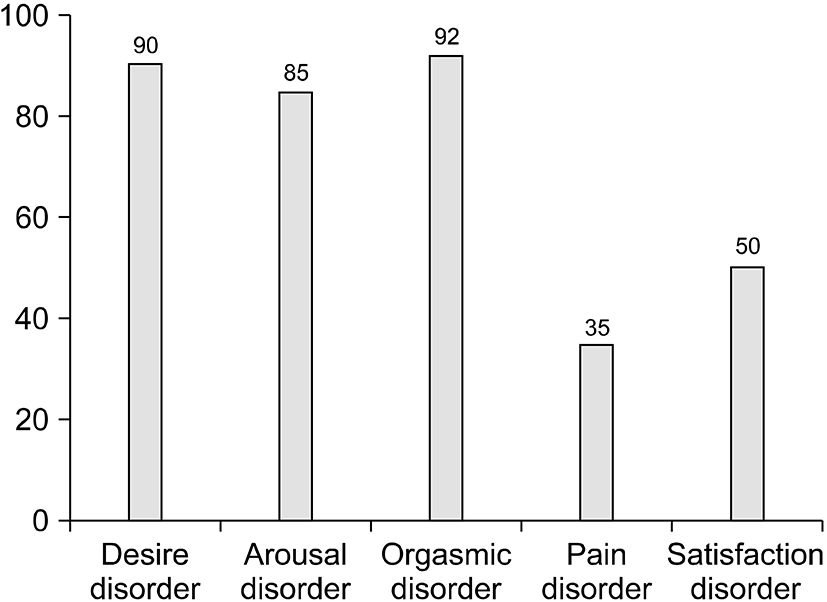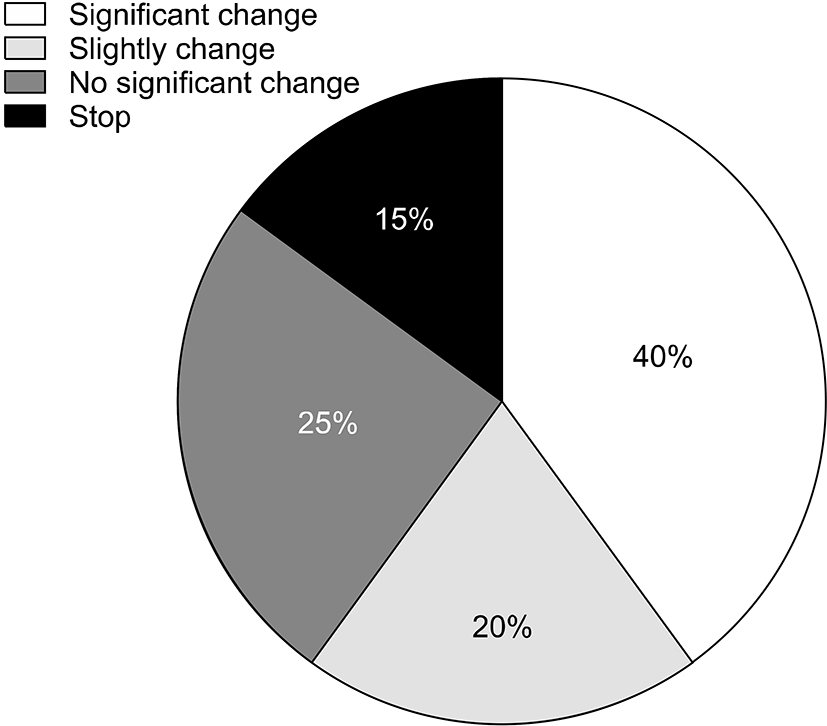Introduction
Female sexual dysfunction has been classified as four distinct disorders-sexual desire disorders (hypoactive and aversion disorders), sexual arousal disorder, orgasmic disorder, and sexual pain disorders (dyspareunia, vaginismus, and other causes) [1,2]. Androgens have been used to treat menopausal symptoms including low libido and other manifestations of a hypoactive sexual desire disorder, but clinical trials have only recently established the beneficial effects of androgens in women with androgen insufficiency [3-5].
Androgen plays an important role in female sexual function and Androgen insufficiency in women is associated with impaired sexual dysfunction [6-9].
This study examined the association between sex hormones and the clinical effect of serum testosterone concentration distribution and testosterone replacement therapy in female sexual dysfunction.
Methods
This study examined 75 female diagnostically significant patients out of the 102 female patients who visited our hospital from March 2002 to June 2008 to treat sexual dysfunction. For all patients, we conducted a physical test including a history taking, vaginal examination, urine test, and a blood test that included a sex hormone test (estradiol, total testosterone, sex hormone binding globulin (SHBG), leuteinizing hormone (LH), follicle stimulating hormone (FSH), dehydroepiandrosterone (DHEA), and DHEA-sulfate (DHEA-S)). In addition, we collected the sex life data of patients based on the Korean version of the Female Sexual Function Index (FSFI-K).
In ELISA way, we measured the target hormone level of patients by taking the patient’s blood sample during the time of each ovulation. In addition, we indirectly measured the free testosterone level of target patients by using their total testosterone level, SHBG, albumin level according to the formula (www.issam.ch/freetesto.htm). The hormone levels were compared between the sexual dysfunction group and control group.
Patients with psychogenic sexual dysfunction were excluded in this research. For the rest of the patients, we performed primary pharmaceutical treatment and physiotherapy in accordance with main cause of their sexual dysfunction. We also performed combination treatment of androgen replacement therapy for patients who did not make medical progress after two months of primary treatment and for patients whose free testosterone level was in the bottom group of the three normal range groups (1.0∼8.5 pg/ml) [10].
For androgen replacement therapy, we applied gel type testosterone (TestogelⓇ 1%, testosterone 10 mg/g gel/pack) on the clean and dry part of the shoulder, arm, or stomach of the patients where there is no hair, in the morning time. The dosage was one third of which applied to men and it was applied to the patients twice a week.
The correlation among serum sex hormone levels, sexual dysfunction, treatment efficacy, safety of the androgen replacement therapy in the selected group was compared and analyzed by statistical methods.
Results
The mean age of the target patients was 39.6±8.7 years (range, 35∼66 years). Among the target patients, ten patients were postmenopausal women, and we had been performing estrogen replacement therapy on them without androgen replacement therapy. The estrogen level for the rest was in the normal range (106.39± 97.38 pg/ml).
According to FSFI and the primary complaint of each patient, their sex life problems were subcategorized into 5 groups, 67 patients (90%) to desire disorder, 63 patients (85%) to arousal disorder, 69 patients (92%) to orgasmic disorder, 26 to patients (35%) pain disorder, 37 to patients (50%) satisfaction disorder (Fig. 1).
The mean levels of LH, FSH, DHEA-S were lower in women with desire disorders (P=0.002, 0.029, and 0.031, respectively). The levels of SHBG and DHEA were higher in women with arousal disorders (P=0.035 and <0.001, respectively). Plasma FSH and DHEA levels were lower in the orgasmic disorder group than the control group (P=0.020 and 0.001, respectively). The levels of E2 or lower in the pain disorder group than the control group (P=0.035). The satisfaction disorder group did not exhibit a significant correlation between plasma sex hormone levels and the domains of sexual function (Table 1).
Among 26 patients who received testosterone replacement therapy through the use of TestogelⓇ, 12 patients reported a subjective improvement of symptoms, 8 patients reported a significant change, and 4 patients reported a slight change. For the rest of the patients, 5 patients had no significant change, 3 patients stopped the therapy because of side effects such as hoarseness and hyperorexia, and 6 patients were lost in the follow up (Fig. 2).
In patients with sexual desire disorder, we performed androgen replacement therapy. 60% (12/20) of the patients were satisfied with their sexual life with hormone replacement therapy.
Discussion
There is a need to consider all issues related with sexual function and approach the issue from many health perspectives in the verification of the cause and treatment of female sexual dysfunction.
At first, reversible treatment is needed in treating female sexual dysfunction. It is important to find and treat all the factors that affect sexual function such as smoking, drinking, habitual dependence on drugs, excessive exercise, diet, chronic stress, fatigue, and depression.
Maintaining proper a hormonal environment for patients is also important because hormone deficiency may increase female sexual dysfunction.
In estrogen and progesterone treatment for premenopausal women, paramenia, abnormal ovulation, and amenorrhea have to be treated. For postmenopausal women, pharmaceutical preparation of estrogen is used if the patient has a uterus, and pharmaceutical preparation of progesterone is used if the patient has no uterus. However, the administration of estrogen may cause a lack of libido or arousal disorder because of a free testosterone decrease. Therefore, the elementary quantum of androgen hormone needs to be combined.
There is a need to be cautious about DHEA treatment for premenopausal women because of side effects such as acne, hirsutism, and hepatotoxicity related to testosterone increase, high density lipoprotein (HDL)-cholesterol decrease, estradiol, and the androgenic effect of increased estrone.
For postmenopausal women, since the administration of DHEA increases serum testosterone, it is effective for androgen insufficiency syndrome and for the increase of bone mass, improvement of constitutional symptoms, and treatment of breast cancer. However, the report about its stability and effect are limited, so we need to be careful of using it and regular blood tests are needed to prevent the development of complications [11].
If dopamine receptor agonist is stimulated with analaptics, sexual impulse, and response is stimulated results in an improvement of sexual desire and awareness. In this case, it is shown that apomorphine is effective and that a melancortin receptor agonist is effective in the improvement of sexual awareness and desire [12,13].
Phosphodiesterase 5 (PDE5) inhibitors and vasodilators are effective in treating female sexual dysfunctions such as sexual desire disorder, sexual awareness disorder, and dyspareunia which all are caused by selective serotonin reuptake inhibitor (SSRI), and that a phentolamine alpha blocker is effective in treating sexual awareness disorder because it broadens blood vessels under a proper estrogen environment [14]. In addition, (even though there are no clinical studies) we might expect curative effect of prostaglandin E1 (PGE1), vasoactive intestinal polypeptide (VIP), and nitric oxide (NO).
As females advanced in age, their testosterone level lowers and the increase of free testosterone level during period is reduced. Testosterone replacement therapy is needed if the testosterone level is lower than expected and may result in sexual dysfunction [15]. However, there is limited evidence about using testosterone for females and the chronic use of testosterone may cause side effects. There exists a need for caution in the use of testosterone for females because there is little evidence of treating premenopausal women with testosterone.
Testosterone replacement therapy is effective in treating androgen insufficiency syndrome. Testosterone replacement therapy is helpful for treating problems such as osteopenia, muscular atrophy, amnesia, cognitive functional change, and sexual dysfunction which all are caused by androgen insufficiency [16].
Low sexual desire and sexual dysfunctions in females have been associated with decreased androgen levels. By effecting the entire sexual response cycle, sex hormones might induce significant changes in sexual desire, arousal, orgasm, and sexual satisfaction.
The research performed by Shifren et al [3] targeted 75 females, 31∼56 years old, who became postmenopausal women because of surgical excision administrated testosterone 150 µg to one group, testosterone 300 mg to another group, and placebo to the other group for 12 weeks. The researchers found that serum total testosterone, free testosterone, and bioavailable testosterone of the control groups increased and the index of sexual function improved. In addition, there were no side effects such as acne, hirsutism, or a change of blood test results caused by the increase of testosterone level.
If serum testosterone and free testosterone decreased without estrogen decrease, sexual dysfunction such as lack of libido and sexual awareness disorder (also known as androgen insufficiency syndrome in females). In this case, androgen replacement therapy is effective in treating a decreased libido, sensory deficiency of external genitalia, and dyspareunia [11].
Female androgen replacement therapy remains controversial, but it is established that the combination of androgen and estrogen is effective in vaginal synovial decrease. Local androgen hormone is admitted as a remedy for vaginal lichen planus and is clinically used [17].
The individual and combined effect of estrogen and androgens on female sexual function is controversial. Estrogens clearly decrease the vasomotor symptoms that can lead to sleep disturbances, which can affect mood, energy, and quality of life. Estrogen also improves vaginal mucus production that reduces dyspareunia and the avoidance of sexual intercourse because of pain. These estrogen-medicated improvements may improve sexual receptivity, but do not improve libido [18].
Female sexual function may be affected by many variables. These include physical factors, emotional health, relationship quality, the environment, cultural beliefs, and hormonal factors. Androgens are thought to influence sexual function in females by their affect on sexual motivation and desire; low testosterone levels have been correlated with sexual infrequency and reduced libido [19].
Greenblatt et al, Salmon and Geist have shown that androgen treatment dramatically increased sexual satisfaction [20,21]. Whether the effects of androgens are mediated by direct action on the nervous system, by effect on the genital organs, or both has not been determined.
Reports of premenopausal women with adequate estrogen levels but low androgen levels suggest potential metabolic alteration in androgen biosynthesis. Thus, the aromatization of androstenedione (the major androgen produced by the ovaries) to estrone and estradiol brings about sufficient estrogen levels, but its conversion to testosterone may be limited, resulting in low levels of testosterone in plasma. Similarly, adrenal insufficiency may result in the low synthesis of androgens. Thus, androgen insufficiency in women may have multiple etiologies and requires further investigation [22].
Previous research reports that an AndriolⓇ supplement is effective in increasing sexual desire in sexual desire disorder patients, but the study also says it does not necessarily mean that AndriolⓇ supplement is improving personal sexual function or sexual satisfaction [23].
This study performed a combination treatment of androgen replacement therapy with TestogelⓇ for patients whose testosterone level is in the bottom group out of the three normal range groups; 60% of the symptoms improved in patients.
Even though we had trouble finding target patients and a significant follow up loss happened during research, we still conclude that androgen replacement therapy is meaningful as an alternative treatment for female sexual dysfunction patients.



